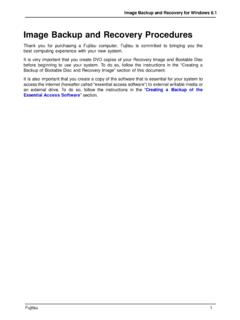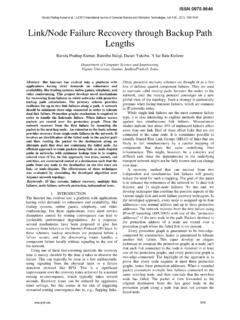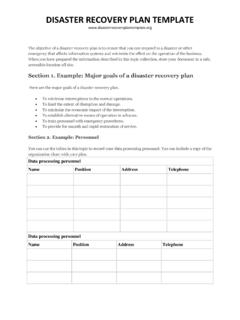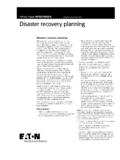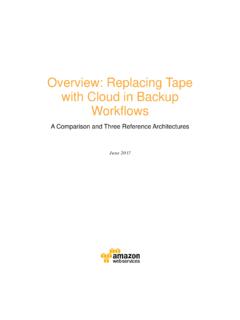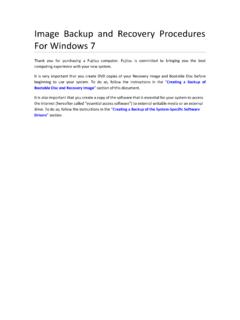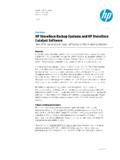Transcription of Tandberg Data SMB Guide to Backup Best Practices
1 Tandberg data SMB Guide to Backup best PracticesData Protection Strategies for the Small-to-Medium Size BusinessFEATURES best Practices to ensure your data is fully protected! Complete checklists for tape migration and Backup Covers both standalone tape drives and autoloadersBEST PRACTICESThe Tandberg data SMB Guide to Backup data Protection Strategies for the Small-to-Medium Size BusinessTable of Contents ..Page 1. About this Guide ..12. data Backup Basics ..2 When Should Backups Take Place? ..2 How Long Should data Be Stored? ..3 Where Should Backup Tapes Be Stored? ..3 How Often Should Tapes Be Retired? ..33. An Introduction to Backup Automation ..4 Labor Savings Through Automation ..44. Types of Backup ..5 Full Backups.
2 5 Partial Backups ..5 Incremental Backups ..5 Differential Backups ..6 Which Backup Strategy is best ..65. Tape Rotation ..8 Six-Tape Rotation ..8 Grandfather - Father - Son (GFS) ..9 Tower of Hanoi ..10 Which Rotation Method is best ? ..116. Planning for Migration ..12 Maintaining your old Backup tape drive ..12 Copying your old backups to the new format ..137. Tape Planning ..14 Determining the Number of Required Tapes ..14 Determining the Cost ..15 Tandberg data Tape Planning the Backup Window ..179. Backup Tape Migration best Practices ..1910. Migration Checklists ..21 data Protection Strategies for the Small-to-Medium Size BusinessBEST PRACTICESThe Tandberg data SMB Guide to Backup data Protection Strategies for the Small-to-Medium Size BusinessSuppose for a moment that a virus infects your entire computer network.
3 The virus spreads through every employee s workstation, into every document and database file. All your work, all your data it s all destroyed. How would your business recover? Without an adequate Backup and recovery plan, your business is at risk. Because your company relies on its data and mission-critical applications, the cost of downtime is exorbitant, potentially exceeding thousands of dollars per hour for such expenses as recovering data and system files, replacing equipment, losing productivity, and losing customers. A recent study1 reveals the precarious position of small business backups: 30% lack formal data Backup and storage procedures, 39% review their storage procedures only after a problem occurs, 34% admit to only fair or poor performance in storing Backup data offsite, 17% don t consistently perform incremental data backups, and 55% rate their disaster recovery plan as fair or poor.
4 According to a disaster recovery study, nearly half of the companies that are unable to fully restore their data after a disaster will go out of business entirely2. Why Tape is Ideal for Backup Whether you are backing up an individual workstation or a small network, tape is an ideal storage medium because it is capable of storing high capacities of information for a relatively low cost. And, tape is perfect for archival because you can store cartridges off-site for enhanced data security. Tape Automation Now Available for SMBs Until recently, tape Backup for the small-to-medium business meant manually inserting tape cartridges into individual tape drives. Tape automation has traditionally been the realm of big-budget IT departments. Now, affordable autoloaders and small tape libraries provide SMBs with the convenience and risk reduction previously available only to large businesses.
5 If you want to reduce the risk of human error in backups or just don t want to spend time manually inserting and removing tapes each time you back up, consider one of today s automated tape solutions. A ten-cartridge autoloader, such as Tandberg data s VXA PacketLoader 1x10 1u, can provide reliable, unattended Backup for up to two weeks for little more than the price of a standalone tape drive. Who Should Read this Guide Read this Guide if you are responsible for protecting data in a small or medium business. It provides information about how to use tape technology for Backup and recovery and how to implement common Backup strategies and tape rotations. NOTE: Whether you already have a tape Backup system in place or you are deciding to purchase a new tape Backup system, you can find helpful advice in this Backup Guide1.
6 About this Guide 1 CRN, September 19, 2003, Precarious Position 2 University of Texas, Center for Research on Information Systems, 1994 SurveyBEST PRACTICESThe Tandberg data SMB Guide to Backup data Protection Strategies for the Small-to-Medium Size BusinessThis chapter addresses some common questions about data Backup . What does it Mean to Back Up, Restore, and Archive? data Backup is the process of transferring data from your company s primary computer system to a separate storage device, such as a tape drive. If the original data is lost or damaged, you can restore the information from the device and resume normal business operations. An archive is a long-term, Permanent data Backup , which is kept off-site. What Types of Files Should Be Backed Up?
7 The most important files to back up are data files the files that change on a frequent basis. Periodically, you should also back up the entire system in case of a catastrophic disaster. This periodic Backup should include system files that contain specific user information for customized settings and passwords. You may also want to back up software files if you no longer have the original disks. Most Backup software provides the option of backing up all files on the drive, the files that have changed since the last Backup , or individually selected files. How Often Should data Be Backed Up? Because data files change every time someone enters new information, many companies back up the data files every day (or only those files that have changed) and then perform a complete Backup of the entire system on a weekly, bi-weekly, or monthly basis.
8 For your company, you can determine the necessary frequency of backups by asking yourself how often the data changes and how critical are the different types of data files. In other words, how much data can you afford to lose without causing your business undue hardship? The best strategy is to devise a schedule that works for the majority of your data files. For example, you can schedule a daily Backup of new and modified data files and then a weekly Backup of all files. If you have critical files that must be backed up more often, you can back up these files throughout the Backup GuideFile typeBack up dailyBack up weeklyData files**Critical files (may be backed up several times a day)**All other files (includes system files and software files)*2.
9 data Backup Basics best PRACTICESThe Tandberg data SMB Guide to Backup data Protection Strategies for the Small-to-Medium Size Backup GuideWhen Should Backups Take Place? Ideally, you should back up data after regular business hours when employee demands on the network are at a minimum. This off-hours time frame is called the Backup window. Most small companies have an adequate Backup window to perform Backup jobs at night and on weekends. However, if your business operates 24 hours a day, 7 days a week (24x7), or if you have employees working in different time zones, you may have little or no Backup window. In this case, you must determine a time period when employees will be the least affected. Alternatively, you may quickly copy your data to other disk storage reserved for that purpose.
10 That storage may then be backed up to tape without impacting the user community. TIP: If your business operates 24x7, use Backup software that has an open file option. This option allows you to perform a Backup while the files are in use. How Long Should data Be Stored? How long you store data depends on the type of data and your business requirements. For data files that change frequently, you should keep only the most recent files. As the previous data becomes obsolete, you can overwrite and reuse the tapes. For the full set of files on your system, you should store the files in a secure, off-site location. By having this complete file set, you can recover the entire system in case a disaster destroys the originals. For certain types of data (tax records, contracts, personnel files, patient records, and so on), you may need to archive data for a specified time period to meet specific legal requirements.
